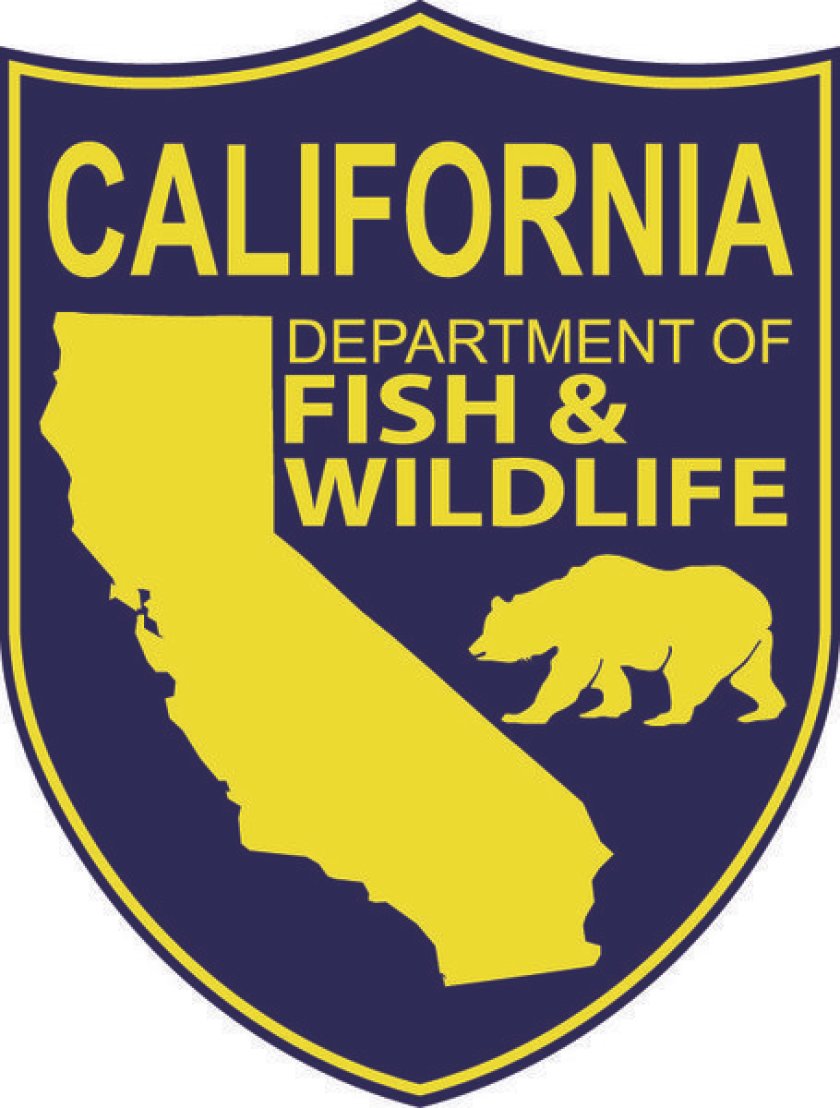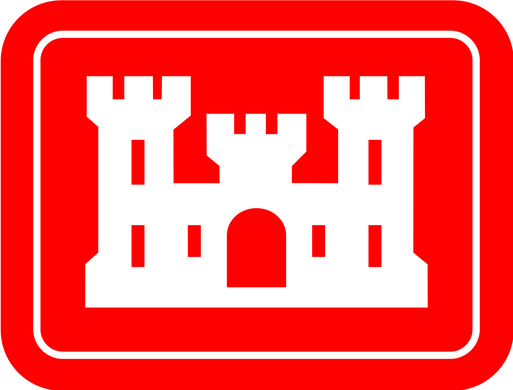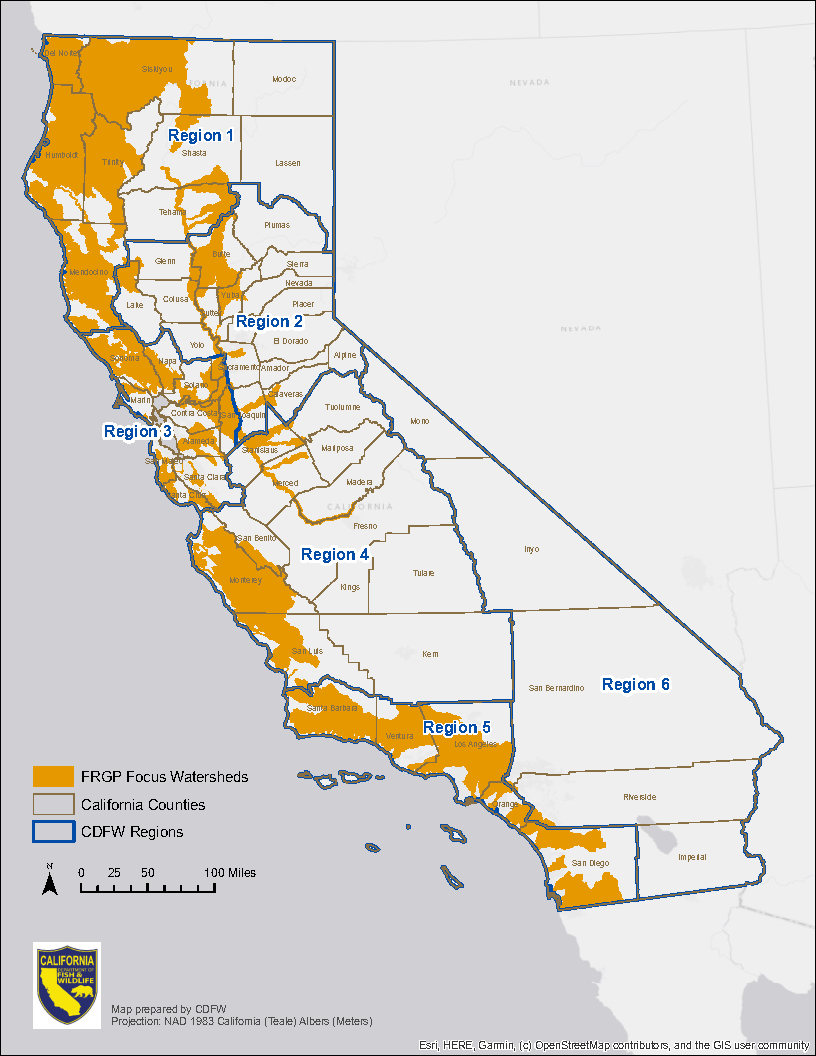Agency or authority
About the Fisheries Restoration Grant Program (FRGP)
The goal of the Fisheries Restoration Grant Program (FRGP), managed by the California Department of Fish and Wildlife (CDFW), is to conserve, protect, and recover salmon and steelhead populations in California. While there are many stressors like pollutants, overfishing and climate change, FRGP tries to accomplish its goal by competitively funding grants to complete a variety of activities, including:
- Projects and activities that provide demonstrable and measurable benefits to Pacific anadromous salmonids and their habitat.
- Restoration projects that address factors limiting the productivity of ESA-listed Pacific salmonids as specified in approved, interim, or proposed Recovery Plans. This includes projects that are a necessary precursor to implementing the restoration projects.
- Effectiveness monitoring of habitat restoration actions at the watershed or larger scales for ESA-listed anadromous salmonids, or status monitoring projects that directly contribute to population viability assessments
- Other projects consistent with but not included in the above, such as outreach, coordination, research, monitoring, and assessment projects that can be justified as directly supporting the goal of the program.
FRGP management activities are divided into five coastal watershed geographical areas (see map to the right) in which CDFW grant managers oversee the implementation of funded restoration projects. For more information on FRGP grants, please visit the FRGP Grant Process page.
Who is Eligible for FRGP Funds
Eligible applicants are limited to state and local government agencies, public entities, California Native American Tribes, and nonprofit organizations. Private individuals and for-profit enterprises interested in submitting restoration proposals are encouraged to work with an eligible entity.
Environmental Compliance and Permitting
Proposals that conduct fishery habitat restoration activities using methods described in California Salmonid Stream Habitat Restoration Manual, 4th Edition (California Department of Fish and Game) (“CA Restoration Manual”) or other approved guidelines and manuals for salmon and steelhead habitat restoration may be covered by the FRGP’s programmatic permits. The two FRGP programmatic permits are the Section 404 (RGP 12 or RGP 78) and the 401 permits of the Clean Water Act (CWA). See more below about each of these, as well as CEQA compliance and information for projects working in the coastal zone.
The applicant is responsible for reviewing the permits and incorporating their required conditions into their proposal. Certain activities (such as fish screens, infiltration galleries, large dam removals, etc.) are ineligible for FRGP programmatic permit coverage. Please contact the FRGP Regulatory Coordinator (see FRGP Contacts) early if you have any questions. Applicants are encouraged to work with CDFW Support Staff prior to submission of their proposal application to determine if the project is eligible for the FRGP programmatic permit coverage.
Other permits that may be required to implement the restoration project must be obtained by the applicant. Examples of other permits that may be required are the Lake and Streambed Alteration Agreement(s), the Construction General Storm Water permit from the Regional Water Resource Control Boards (which may include provisions for dewatering), and other permits from local/state governments or municipalities. If the project includes dewatering and/or species exclusion/relocation, take coverage may be authorized through a CDFW incidental take permit, or expedited pathways like the Habitat Restoration and Enhancement Act (HREA). The approval must be submitted to the CDFW grant manager before each species relocation activity.
CA Environmental Quality Act (CEQA)
Projects that are designed to be consistent with the California Salmonid Stream Habitat Restoration Manual, 4th Edition, and for which no CEQA documentation has yet been prepared, will be included within the environmental document prepared by CDFW as a lead agency for CEQA. Projects seeking to use other approved guidelines and manuals for salmon and steelhead habitat restoration must confirm permit coverage with FRGP’s Permit Coordinator (see FRGP Contacts). Qualifying projects may also seek CEQA coverage through the Statutory Exemption for Restoration Projects (SERP).
State Water Resources Control Board (SWRCB)
The FRGP program provides coverage under Section 401 of the Clean Water Act through a 401 Water Quality Certification for a batch of projects annually. The CEQA compliance and 401 certification are exclusive together. Therefore, projects obtaining their own CEQA compliance will also need to obtain their own 401 certification.
U.S. Army Corps of Engineers (USACE)
Projects in the FRGP program can receive Section 404 coverage under an Army Corps Regional General Permit (12, 16, or 78) depending on what Corps district your project is in.
RGP 12 is under the San Francisco Corps District.
Regional General Permit 16 – Aquatic Habitat Restoration and Enhancement Activities is under the Sacramento Corps District.
- RGP 16 Full Text
- RGP 16 Attachments
RGP 78 is under the Los Angeles Corps District.
California Coastal Commission
Projects working in or near the Coastal Zone may need a Coastal Development Permit (CDP). FRGP has coordinated with the California Coastal Commission to develop a Master CDP that will allow FRGP to apply and hold a CDP on behalf of eligible FRGP funded projects. Applicants with projects in or near the Coastal Zone should confirm permit coverage with FRGP’s Regulatory Coordinator (see FRGP Contacts). Specific project permit information will be collected if a project is awarded. Interested grantees should be prepared to supply this additional CDP information to be covered by FRGP’s Master CDP.
Projects working in tidally influenced areas are encouraged to reach out to NOAA Support Staff contacts (see FRGP Contacts), before submitting a proposal to FRGP, to discuss the project and possible Coastal Act coverage under NOAA’s Restoration Center’s Federal Consistency Determinations (North and Central Coast CD or South Coast CD.)
Applicable locations
See the FRGP Focus Tools map as a guideline to help you find your project within the correct watershed. Focus determination for a project will be based on the Focus Table in the PSN, Part III, not on these maps. If you have any questions about your project location, please reach out to your regional contact.
How to apply
The FRGP grant program operates on an annual grant cycle. Soliciting, reviewing , permitting, awarding, and executing grants within an approximately 12- month period. See the FRGP timeline here.
Every January /February FRGP releases the upcoming Proposal Solicitation Notice (PSN) for public comment and review. The Open Solicitation period is when FRGP accepts proposal applications. Applications must be submitted through CDFW’s WebGrants.
May be used with:
- USACE Regional General Permit 16 – Aquatic Habitat Restoration and Enhancement Activities (Sacramento District)
- North Coast NMFS Programmatic Biological Opinion (PBO)
- Central Coast NMFS Programmatic Biological Opinion (PBO)
- North and Central Coast Federal Consistency Determination (CD) – Coastal Commission and NOAA Restoration Center
- Central Valley NMFS Programmatic Biological Opinion (PBO)
- South Coast NMFS Programmatic Biological Opinion (PBO)
- CDFW Habitat Restoration and Enhancement Act (HREA)
- CDFW Restoration Consistency Determination (CD)
- CDFW Restoration Management Permit (RMP)
- USFWS Statewide Restoration Programmatic Biological Opinion (PBO)
Example projects
See the CDFW site for a full list of projects funded under this grant
Activities covered
FRGP funds a wide range of projects that focus on, or lead to, restoring, enhancing, or protecting salmonid habitat in anadromous watersheds of California. For information on projects funded in previous years, please visit the FRGP Funded Project Summaries page.
Exclusions
No project that is required mitigation or used for mitigation under the CEQA, CESA, ESA, National Environmental Policy Act (NEPA), California Forest Practices Act (FPA), or Section 404 of the Clean Water Act (CWA) will be considered for funding. No project that is under an enforcement action by a regulatory agency will be considered for funding.
Application Tips and Resources
Applicants who wish to be covered through FRGP permitting are encouraged to reach out to FRGP’s Regulatory Coordinator (see FRGP Contacts) as early as possible to consult on potential coverage and requirements.
- Grant Process
- Proposal Solicitation Notice
- Proposal Funding Summaries
- Restoration Manual, PSN Info, and other Guidance Tools
- FRGP Map Viewer in BIOS






